Changes in p19Arf localization accompany apoptotic crisis during pre-B-cell transformation by Abelson murine leukemia virus
- PMID: 18579612
- PMCID: PMC2519686
- DOI: 10.1128/JVI.00348-08
Changes in p19Arf localization accompany apoptotic crisis during pre-B-cell transformation by Abelson murine leukemia virus
Abstract
Transformation by Abelson murine leukemia virus (Ab-MLV) is a multistep process in which growth-stimulatory signals from the v-Abl oncoprotein and growth-suppressive signals from the p19(Arf)-p53 tumor suppressor pathway oppose each other and influence the outcome of infection. The process involves a proliferative phase during which highly viable primary transformants expand, followed by a period of marked apoptosis (called "crisis") that is dependent on the presence of p19(Arf) and p53; rare cells that survive this phase emerge as fully transformed and malignant. To understand the way in which v-Abl expression affects p19(Arf) expression, we examined changes in expression of Arf during all stages of Ab-MLV transformation process. As is consistent with the ability of v-Abl to stimulate Myc, a transcription factor known to induce p19(Arf), Myc and Arf are induced soon after infection and p19(Arf) is expressed. At these early time points, the infected cells remain highly viable. The onset of crisis is marked by an increase in p19(Arf) expression and a change in localization of the protein from the nucleoplasm to the nucleolus. These data together suggest that the localization and expression levels of p19(Arf) modulate the effects of the protein during oncogenesis and reveal that the p19(Arf)-mediated response is subject to multiple layers of regulation that influence its function during Ab-MLV-mediated transformation.
Figures

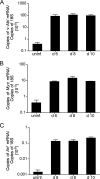
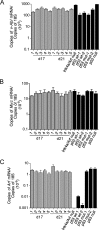

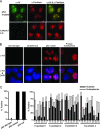
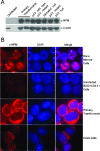
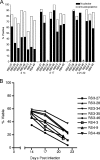
Similar articles
-
p19(Arf) induces p53-dependent apoptosis during abelson virus-mediated pre-B cell transformation.Proc Natl Acad Sci U S A. 1998 Oct 27;95(22):13194-9. doi: 10.1073/pnas.95.22.13194. Proc Natl Acad Sci U S A. 1998. PMID: 9789064 Free PMC article.
-
p16(Ink4a) interferes with Abelson virus transformation by enhancing apoptosis.J Virol. 2004 Apr;78(7):3304-11. doi: 10.1128/jvi.78.7.3304-3311.2004. J Virol. 2004. PMID: 15016851 Free PMC article.
-
p53 mediates apoptotic crisis in primary Abelson virus-transformed pre-B cells.Mol Cell Biol. 1999 Jul;19(7):4825-31. doi: 10.1128/MCB.19.7.4825. Mol Cell Biol. 1999. PMID: 10373532 Free PMC article.
-
Loss of heterozygosity at the Ink4a/Arf locus facilitates Abelson virus transformation of pre-B cells.J Virol. 2000 Oct;74(20):9479-87. doi: 10.1128/jvi.74.20.9479-9487.2000. J Virol. 2000. PMID: 11000217 Free PMC article.
-
Absence of p53 complements defects in Abelson murine leukemia virus signaling.J Virol. 2003 Jun;77(11):6208-15. doi: 10.1128/jvi.77.11.6208-6215.2003. J Virol. 2003. PMID: 12743277 Free PMC article.
Cited by
-
Heterokaryon technique for analysis of cell type-specific localization.J Vis Exp. 2011 Mar 11;(49):2488. doi: 10.3791/2488. J Vis Exp. 2011. PMID: 21445034 Free PMC article.
References
-
- Apicelli, A. J., L. B. Maggi, Jr., A. C. Hirbe, A. P. Miceli, M. E. Olanich, C. L. Schulte-Winkeler, A. J. Saporita, M. Kuchenreuther, J. Sanchez, K. Weilbaecher, and J. D. Weber. 2008. A non-tumor suppressor role for basal p19ARF in maintaining nucleolar structure and function. Mol. Cell. Biol. 281068-1080. - PMC - PubMed
-
- Chesebro, B., K. Wehrly, M. Cloyd, W. Britt, J. Portis, J. Collins, and J. Nishio. 1981. Characterization of mouse monoclonal antibodies specific for Friend murine leukemia virus-induced erythroleukemia cells: Friend-specific and FMR-specific antigens. Virology 112131-144. - PubMed
-
- Falini, B., C. Mecucci, E. Tiacci, M. Alcalay, R. Rosati, L. Pasqualucci, R. La Starza, D. Diverio, E. Colombo, A. Santucci, B. Bigerna, R. Pacini, A. Pucciarini, A. Liso, M. Vignetti, P. Fazi, N. Meani, V. Pettirossi, G. Saglio, F. Mandelli, F. Lo-Coco, P. G. Pelicci, and M. F. Martelli. 2005. Cytoplasmic nucleophosmin in acute myelogenous leukemia with a normal karyotype. N. Engl. J. Med. 352254-266. - PubMed
Publication types
MeSH terms
Substances
Grants and funding
LinkOut - more resources
Full Text Sources
Research Materials
Miscellaneous

